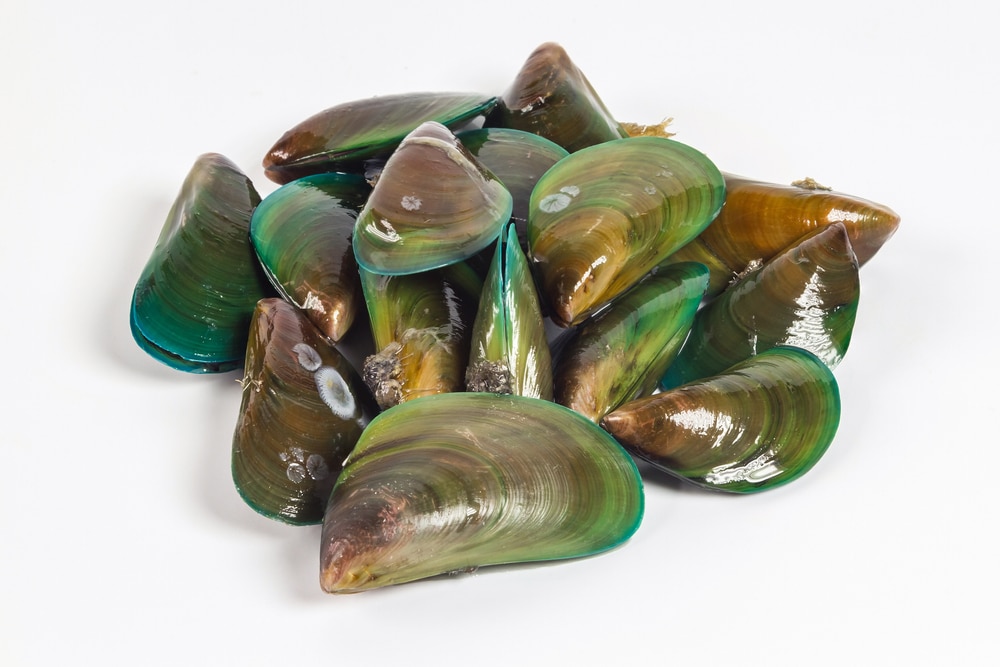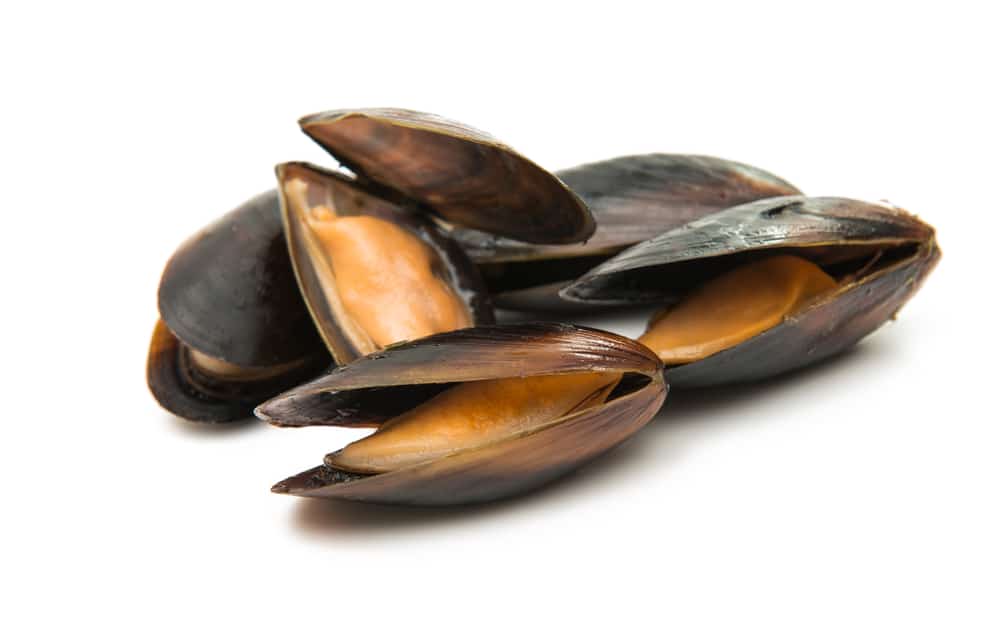The main difference between green mussels vs black mussels is color and taste. Green mussels have gray to green shells and a mild flavor, while black mussels are more intense and have a darker shell.
- Appearance: Green mussels are large and meaty, boasting a light gray or green shell. Black mussels are smaller and have a black or dark gray shell.
- Flavor: Green mussels have a light, mild flavor and a chewy texture. Black mussels are softer but boast a more intense seafood flavor.
- Shelf Life: Both green and black mussels have a maximum shelf life of around seven to ten days in the refrigerator. In the freezer, shellfish such as mussels can last for two to three months.
- Use Cases: Green and black mussels are typically used interchangeably depending on personal tastes. Green mussels will lend more texture to dishes, while black mussels add bold flavor.
Comparison Table Between Green Mussels and Black Mussels
| Location | Color | Size | Flavor | Texture | Shelf Life | Use Cases | |
| Green Mussels | New Zealand | Green or gray | Up to 2.5 inches | Mild and sweet | Firm and chewy | 7 to 10 days | Seafood dishes |
| Black Mussels | Worldwide | Black | Up to 6 inches | Intense | Soft and tender | 7 to 10 days | Seafood dishes |
Can You Substitute Green Mussels for Black Mussels?
While the two might look completely different, green mussels and black mussels have a fairly similar flavor profile. Both will complement any seafood pairings such as white wine, citrus, or olive oil just as well as the other.
For this reason, people often substitute green mussels and black mussels for one another. Both are equally delicious when served steamed or fried, and you can incorporate both into dishes such as pasta, soup, paella, and more.
While it’s easy to swap out black and green mussels, it’s important to remember that black varieties tend to have a more intense taste.
If you use black mussels in place of green, you can expect your meal to boast a strong seafood flavor. Conversely, if you sub green mussels for black, you may lose some flavor in your end dish.
In cases where texture is important, substituting black mussels for green may affect the consistency of your dish. Green mussels have tougher meat than black mussels, even after steaming.
People often end up substituting mussels in a dish because of local availability. Green mussels are more of a challenge to find than black mussels and, based on both size and availability, they tend to be more expensive.
It’s often easier to find black mussels in U.S. seafood markets at affordable prices, and so many home chefs end up swapping out green mussels in favor of black. It’s fine to use more readily available black mussels as a green mussel substitute, though dishes may taste fishier.
If you have spare green or black mussels on hand, both can make a good substitute for other similar shellfish in recipes. Mussels make an excellent alternative to oysters or clams, and you can usually find black varieties sold at more affordable prices.
What Are Green Mussels?

It’s easy to recognize a green mussel thanks to the brilliant green bands you can often see on its shell. However, green mussels can range anywhere from emerald to light gray.
Most mature green mussels you see at the market are also large compared to other species. The largest specimens can reach up to six inches with a thick, meaty interior.
Their size often makes green mussels more expensive than black varieties. Limited availability can also raise the price per pound for green mussels.
They come primarily from New Zealand, which is why green mussels are also known as “New Zealand Mussels.” You can also find green mussels along coastlines in North and South America.
It can be challenging to find green mussels in most U.S. seafood markets. Instead, they’re more widely available and affordable near harvesting grounds. It’s easiest to find cheap green mussels in areas such as New Zealand.
People prize green muscles for their mild, almost sweet taste. They don’t overpower dishes with seafood flavor the same way that black mussels sometimes do.
Green mussels have relatively tough meat and are chewier than most other shellfish. Steaming or frying can help to make the meat more tender. However, some people still find their texture to be rubbery.
How to Use Green Mussels
You can also eat green mussels straight from the shell. Mussels are a popular appetizer dish and can also work as a flavorful side for your main course. Simply crack open the shell by hand and use your teeth to scrape out the meat. You may want to drizzle lemon juice, butter, or sauce to enhance the flavor.
One of the most popular ways to cook green mussels is by steaming them. It helps to tenderize the meat somewhat for a more pleasant dining experience. Because of their size and their tough meat, green mussels take longer to cook than black. You should steam them for about ten to 12 minutes for the best results.
Whether you choose to eat your mussels whole or include them in a recipe, it’s important to ensure that you’re getting quality meat. Contaminated shellfish can lead to serious cases of food poisoning and may even result in a trip to the emergency room.
It’s best to buy green mussels live whenever possible. Not only do you know that you’re getting fresh, healthy meat, but you’ll also end up with a better-tasting meal.
Look for a shell that’s shiny, moist, and with vivid shades of green. Live mussels should be slightly open but will close when you tap them. If a live mussel doesn’t respond to your touch, it’s likely sick or dying.
While it’s natural for mussels to smell somewhat fishy, they shouldn’t smell too strongly. An overpowering smell may indicate rancid meat.
Once you’ve chosen a batch of fresh, delicious mussels, you need to know how to prepare them for cooking. Cultured mussels are often ready to throw straight in the steamer pot, but wild mussels may require some cleaning.
Wild mussels will boast a byssus on their underside, which looks like a small beard. Mussels use this appendage to attach to rocks, but you should remove it before cooking. Otherwise, it may affect the taste of your meal.
What Are Black Mussels?

Black mussels are easier to find than green ones at most seafood markets. They can tolerate cooler waters and are found year-round and worldwide on Pacific and Atlantic coastlines. Black clams are abundant in North America, both wild-caught and farmed.
Often, it’s easier to find black mussels than varieties such as green, especially in U.S. supermarkets. Black mussels are also more affordable thanks to their year-round availability and are cheaper than seafood choices such as clams, oysters, crabs, or shrimp.
Black mussels are smaller than green, reaching only around two and a half inches long at maturity. It’s easy to identify a black mussel thanks to its shell, which will be a uniform black to gray color. Unlike blue mussels, there is no aqua ring around the lip of the shell.
Many seafood enthusiasts prefer black mussels for their bold flavor. However, some people find that the taste can overpower complex dishes and delicate sauces.
Black mussels also have a soft, buttery texture that blends well into other dishes. They are also easier to eat alone than green muscles, especially for those sensitive to consistency.
How to Use Black Mussels
While many people choose to eat black mussels on the shell or half-shell, they also work well in most seafood dishes. Though their taste can be strong, it complements dishes paired with citrus, wine, and olive oil.
People often eat black mussels alone to make the most of their rich flavor. Sometimes, they get served with a side of butter or sauce. Black mussels practically melt in the mouth when properly cooked thanks to their soft texture.
One of the most popular ways to prepare black mussels, like green mussels, is by steaming them. Since black mussels are smaller, they have a shorter steaming time than green mussels. It only takes around five to seven minutes to get perfectly tender meat.
You should take just as much care picking out black mussels as green. Live, healthy mussels make the best choice in terms of both taste and food safety. Always make sure to investigate the shell for slickness, color, and smell. If a mussel is not open or does not close when you tap it, you shouldn’t buy it.
Both green and black mussels make a tasty treat for anyone who loves the taste of seafood. Though the two differ slightly in taste and texture, you can use both interchangeably in almost any recipe.
You might also be interested in: clams vs mussels differences.







